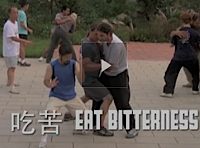
|
More and more I find that the beauty of the Taijiquan lies in its simplicity. 大道至简 da dao zhi jian – the overarching theory is the simpliest. Every action is expected to follow the one principle of Separation of Yin and Yang. Initially when we learn the taijiquan, we may find that a lot of rules and restrictions are given to us. Practical Method provides a systematic approach to learn taijiquan. Over time with every practice we do, the often seeming conflicts are resolved, and the goal of achieving the one principle becomes much clearer. The keywords that I most often repeat during practice and teaching are the following, they are important rules and methods that will eventually lead us to comply with separation of yin and yang:
- In with elbow
- Out with hand
- Don’t Move/Fix/Lock
- Fixed Point
- Stretch
- Open
- Match
- Indirect Power
- Triangle
- Single Lock/On a track
- Double Lock
- Take out space/No gap
- Add one
- Don’t let go
- No retreat
- Adjust
- Peng
- Rotation
- Don’t push/Don’t fight
- No protusion
- No indentation
- No feeling



{ 1 comment… read it below or add one }
Kelvin, it is of course true, that Taiji is the split of Yin and Yang. But it is also, according to a Video from GM Chen, a sequence of consecutive splittings on our body to achieve higher levels: 2⁰, 2¹, 2², 2³, …
I assume that 2⁰ is Wuji, then 2¹ is Taiji and then further splittings of each split into higher resolution, so to say. What i really want to try to find out and to describe is, is what is the relation of the concept of splitting of Yin and Yang and the desired “State of Taiji” ( = Peng-Energy?). The exponents in the power of two sequence, interpreted as a lever in the stick model, are the pivots. So the more pivots designated or produced on the body, the more pairs of Yin and Yang are produced. Would this be the mechanical description of Peng-energy in the body to have multiple sets of levers working together? Or is this the wrong approach to try to explain Peng in Taiji in a mechanical sense?
Grandmaster Chen ones told me, it was in 2010 shortly before my trip to DQS, that Peng=Taiji=Life. This is of course a proposition of the Grandmaster, that is beyond the scope of ordinary humans. People who attended the recent Berlin workshop reading this might understand why Grandmaster Chen spoke of the one and only (internal) medicine.